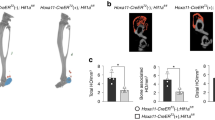Abstract
Purpose
Mesenchymal progenitor cells (MPCs) are capable of differentiating into osteo/chondrogenic cells to contribute substantially to heterotopic ossification (HO). This study aimed to examine the impact of hypoxia on MPCs in the aetiology of HO.
Methods
MPCs from human normal and HO skeletal tissue were cultivated under normoxia and hypoxia. Gene expression of factors which have a key role in HO aetiology (BMPs, COX-1 and COX-2, etc.) were examined by real-time PCR. Tissue of both groups was analysed by immunohistochemistry.
Results
Under hypoxia, COX-1, -2 and SOX-9 gene expression was elevated in HO MPCs, whereas in normal muscle tissue only COX-2 was upregulated. MPCs from HO had a significantly elevated gene expression of BMP-4 and decreased expression of BMP-1 and HIF-1 under hypoxia compared to normal MPCs. Immunohistochemistry detected no significant differences between normal and HO tissue.
Conclusions
Hypoxia causes an enhanced gene expression of factors, which have a key role in HO pathophysiology. A better understanding of this entity will possibly allow reducing HO rates in orthopaedic and trauma surgery.



Similar content being viewed by others
References
Kan L, Kessler JA (2011) Animal models of typical heterotopic ossification. J Biomed Biotechnol 2011:309287. doi:10.1155/2011/309287
Shore EM, Xu M, Feldman GJ et al (2006) A recurrent mutation in the BMP type I receptor ACVR1 causes inherited and sporadic fibrodysplasia ossificans progressiva. Nat Genet 38:525–527. doi:10.1038/ng1783
Cipriano CA, Pill SG, Keenan MA (2009) Heterotopic ossification following traumatic brain injury and spinal cord injury. J Am Acad Orthop Surg 17:689–697
Potter BK, Forsberg JA, Davis TA et al (2010) Heterotopic ossification following combat-related trauma. J Bone Joint Surg Am 92(Suppl 2):74–89. doi:10.2106/JBJS.J.00776
Barbato M, D’Angelo E, Di Loreto G et al (2012) Adherence to routine use of pharmacological prophylaxis of heterotopic ossification after total hip arthroplasty: results from an Italian multicenter, prospective, observational survey. J Orthop Traumatol: Off J Ital Soc Orthop Traumatol 13(2):63–67. doi:10.1007/s10195-012-0180-4
Brooker AF, Bowerman JW, Robinson RA, Riley LH Jr (1973) Ectopic ossification following total hip replacement. Incidence and a method of classification. J Bone Joint Surg Am 55:1629–1632
Shore EM, Kaplan FS (2010) Inherited human diseases of heterotopic bone formation. Nat Rev Rheumatol 6:518–527. doi:10.1038/nrrheum.2010.122
Shimono K, Uchibe K, Kuboki T, Iwamoto M (2014) The pathophysiology of heterotopic ossification: current treatment considerations in dentistry. Jpn Dent Sci Rev 50:1–8. doi:10.1016/j.jdsr.2013.07.003
Nesti LJ, Jackson WM, Shanti RM et al (2008) Differentiation potential of multipotent progenitor cells derived from war-traumatized muscle tissue. J Bone Joint Surg Am 90:2390–2398. doi:10.2106/JBJS.H.00049
Kan L, Kessler JA (2014) Evaluation of the cellular origins of heterotopic ossification. Orthopedics 37:329–340. doi:10.3928/01477447-20140430-07
Jackson W, Aragon A, Djouad F et al (2009) Mesenchymal progenitor cells derived from traumatized human muscle. J Tissue Eng Regen Med 3:129–138. doi:10.1002/term.149
Olmsted-Davis E, Gannon FH, Ozen M et al (2007) Hypoxic adipocytes pattern early heterotopic bone formation. Am J Pathol 170:620–632. doi:10.2353/ajpath.2007.060692
Salisbury E, Rodenberg E, Sonnet C et al (2011) Sensory nerve induced inflammation contributes to heterotopic ossification. J Cell Biochem 112:2748–2758. doi:10.1002/jcb.23225
Pfander D, Cramer T, Schipani E, Johnson RS (2003) HIF-1alpha controls extracellular matrix synthesis by epiphyseal chondrocytes. J Cell Sci 116:1819–1826
Zimmermann SM, Würgler-Hauri CC, Wanner GA et al (2013) Echinomycin in the prevention of heterotopic ossification—an experimental antibiotic agent shows promising results in a murine model. Injury 44:570–575. doi:10.1016/j.injury.2012.12.030
Grässel S, Rickert M, Opolka A et al (2010) Coculture between periosteal explants and articular chondrocytes induces expression of TGF-beta1 and collagen I. Rheumatology (Oxford) 49:218–230. doi:10.1093/rheumatology/kep326
Jackson WM, Aragon AB, Bulken-Hoover JD et al (2009) Putative heterotopic ossification progenitor cells derived from traumatized muscle. J Orthop Res 27:1645–1651. doi:10.1002/jor.20924
Brunnekreef JJ, Hoogervorst P, Ploegmakers MJ et al (2013) Is etoricoxib effective in preventing heterotopic ossification after primary total hip arthroplasty? Int Orthop 37:583–587. doi:10.1007/s00264-013-1781-0
Nauth A, Giles E, Potter BK et al (2012) Heterotopic ossification in orthopaedic trauma. J Orthop Trauma 26:684–688. doi:10.1097/BOT.0b013e3182724624
Salisbury EA, Lazard ZW, Ubogu EE et al (2012) Transient brown adipocyte-like cells derive from peripheral nerve progenitors in response to bone morphogenetic protein 2. Stem Cells Transl Med 1:874–885. doi:10.5966/sctm.2012-0090
Board TN, Karva A, Board RE et al (2007) The prophylaxis and treatment of heterotopic ossification following lower limb arthroplasty. J Bone Joint Surg (Br) 89:434–440. doi:10.1302/0301-620X.89B4.18845
Kluk MW, Ji Y, Shin EH et al (2012) Fibroregulation of mesenchymal progenitor cells by BMP-4 after traumatic muscle injury. J Orthop Trauma 26:693–698. doi:10.1097/BOT.0b013e3182712adf
Rodenberg E, Azhdarinia A, Lazard ZW et al (2011) Matrix metalloproteinase-9 is a diagnostic marker of heterotopic ossification in a murine model. Tissue Eng A 17:2487–2496. doi:10.1089/ten.TEA.2011.0007
Acknowledgments
The authors would like to thank Mr. Matthias Munding and Mrs. Nicole Richter for their excellent technical assistance and contribution to this study
Funding
This study was funded by the Medical Faculty of the University of Regensburg (ReFormA).
Conflict of interest
The authors declare that they have no competing interests.
Author information
Authors and Affiliations
Corresponding author
Rights and permissions
About this article
Cite this article
Winkler, S., Niedermair, T., Füchtmeier, B. et al. The impact of hypoxia on mesenchymal progenitor cells of human skeletal tissue in the pathogenesis of heterotopic ossification. International Orthopaedics (SICOT) 39, 2495–2501 (2015). https://doi.org/10.1007/s00264-015-2995-0
Received:
Accepted:
Published:
Issue Date:
DOI: https://doi.org/10.1007/s00264-015-2995-0




